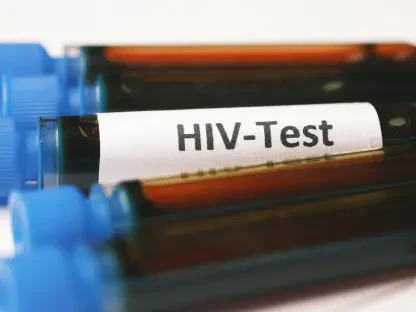In an era where wearable technology has become a cornerstone of personal wellness, the quest for a device that transcends mere fitness tracking to focus on long-term health and vitality has never been more critical. With an aging population increasingly prioritizing longevity, the market is flooded with gadgets promising to monitor every step and heartbeat, yet few delve into the deeper metrics that truly matter for a healthier, longer life. Enter the latest innovation from a leading name in wearable tech—a device that shifts the paradigm from counting calories to understanding the body’s intricate signals for sustained well-being. This screen-less wristband, paired with a robust app ecosystem, aims to redefine how health data is collected and interpreted, offering a glimpse into physiological age and recovery needs. As more individuals seek tools to optimize their lifestyle for the long haul, this release sparks curiosity about whether it can truly stand as a game-changer in the pursuit of enduring health.
Unveiling the Design and Features
Evolving Comfort and Usability
The design of this latest wearable marks a significant step forward from its predecessor, focusing on user comfort for continuous wear. Roughly 7% smaller than the previous model, the device feels less intrusive on the wrist, making it ideal for 24/7 tracking, especially during sleep. This subtle reduction in size enhances its appeal for those who dislike bulky gadgets, though it comes with a caveat—existing accessories like bands and chargers from earlier versions are incompatible, potentially disappointing loyal users. Beyond aesthetics, the battery life has seen a remarkable upgrade, now lasting up to two weeks compared to just a few days in the prior iteration. This extended duration minimizes the inconvenience of frequent charging, a common frustration with wearables. Additionally, a wireless on-wrist charging option, available through premium subscription tiers, allows recharging without removing the band, further streamlining the user experience for those committed to uninterrupted health monitoring.
Innovative Metrics for Holistic Wellness
At the heart of this device lies its focus on three core metrics that paint a comprehensive picture of well-being: Recovery, Strain, and Sleep. Recovery offers a daily score from 0 to 100%, calculated using factors like Heart Rate Variability (HRV), Resting Heart Rate (RHR), and sleep quality, signaling how prepared the body is for daily challenges. Strain evaluates the cardiovascular load from both exercise and routine activities, guiding users on necessary rest periods. Meanwhile, Sleep tracking dives deep into stages such as REM, deep, and light sleep, providing a performance score alongside tailored bedtime suggestions. Unlike traditional fitness trackers that prioritize step counts or calories burned, these metrics aim to deliver actionable insights into overall health, encouraging users to make informed decisions about their lifestyle. This approach positions the device as a companion for those looking beyond short-term fitness goals to foster enduring wellness through data-driven habits.
Diving into Health-Focused Advancements
Medical-Grade Features for Deeper Insights
What sets this wearable apart from standard fitness trackers is its suite of medical-grade capabilities, designed to offer a window into long-term health trends. The introduction of a feature that calculates physiological age based on various health indicators provides users with a unique perspective on how their lifestyle impacts vitality over time. Additionally, an on-demand ECG function screens for potential signs of Atrial Fibrillation (AFib), a critical marker for cardiovascular health. Beta features like daily blood pressure estimates and hormonal insights—tailored specifically for women to address cycle-related effects on recovery and sleep—further elevate its utility. These advancements transform the device into a tool that goes beyond surface-level tracking, catering to individuals who prioritize understanding their body’s deeper signals. For middle-aged users or those focused on longevity, such features offer invaluable data to guide health-conscious decisions.
Accuracy and Performance in Real-World Use
When it comes to precision, this device stands out with its ability to collect data at an impressive frequency of every 19 milliseconds, outpacing many competitors in the wearable market. Comparative testing against other high-end devices has shown consistent results in tracking health metrics over extended periods, reinforcing its reliability for users seeking dependable insights. However, it’s worth noting that while the wearable excels in long-term wellness monitoring, it may not match the real-time specificity of dedicated sports watches for activities like running or cycling. Its strength lies in providing a broader view of health trends rather than immediate feedback during workouts. This distinction makes it a specialized tool for those who value sustained health data over momentary performance stats, carving a niche for itself among users who aim to optimize recovery and overall vitality through meticulous, ongoing analysis.
Assessing the Subscription Model and Value
Balancing Cost with Personalized Benefits
A pivotal aspect of this wearable is its subscription-based model, which unlocks access to a sophisticated app, AI-driven coaching, and regular feature updates. Unlike devices that require a one-time purchase, this ongoing membership can feel like a significant investment, especially with commitments spanning 12 months or more. For some, the cost may raise questions about accessibility, particularly when compared to alternatives that don’t require recurring fees. Yet, the depth of personalized insights—ranging from recovery scores to tailored sleep recommendations—could justify the expense for individuals deeply invested in a data-driven approach to wellness. The subscription ensures that the device evolves with new features over time, keeping it relevant in a fast-paced tech landscape. This model reflects a shift toward continuous value delivery, appealing to those who see health tracking as a long-term commitment rather than a one-off purchase.
Long-Term Appeal for Health Enthusiasts
For users dedicated to understanding their body on a profound level, the subscription model offers a compelling trade-off with its comprehensive ecosystem. The integration of medical-grade features like physiological age tracking and ECG capabilities adds layers of value that are rare in the wearable market, particularly for those prioritizing longevity. While the upfront and ongoing costs might deter casual users, the device’s “always-on” nature and focus on holistic health insights cater to a specific demographic—think middle-aged individuals or wellness enthusiasts eager to fine-tune their lifestyle. The lack of real-time activity specificity might limit its appeal for athletes needing instant feedback, but its strength in long-term data analysis fills a unique gap. Ultimately, the decision to invest hinges on whether the user values sustained, personalized health guidance over traditional fitness tracking, making it a tailored choice for a discerning audience.
Reflecting on a Health-Centric Legacy
Looking back, the journey of this wearable highlights a bold shift in the landscape of personal health technology, emphasizing longevity over fleeting fitness metrics. Its refined design, extended battery life, and medical-grade innovations like ECG screening and physiological age tracking carve a distinct path, setting a benchmark for what health-focused wearables could achieve. The subscription model, though a point of contention for some, underscores a commitment to evolving user experiences through continuous updates and personalized insights. For those who embraced it, particularly individuals focused on sustained well-being, the device proved to be a powerful ally in decoding the body’s complex signals. Moving forward, the challenge lies in broadening accessibility while maintaining the depth of data that defines its appeal. As the wearable tech industry continues to evolve, exploring hybrid models or tiered pricing could ensure that such transformative tools reach a wider audience, paving the way for a future where health tracking truly prioritizes long-term vitality.









